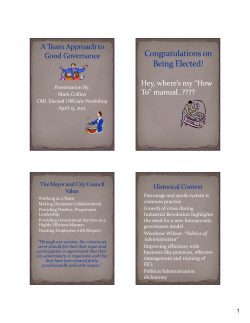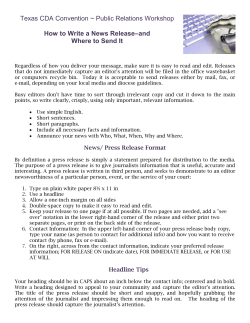
Teaching how to read and write science: a library-journal partnership Jelka Petrak
Teaching how to read and write science: a library-journal partnership Jelka Petrak Central Medical Library, Zagreb University School of Medicine, Zagreb, Croatia Content • Context – Croatian Medical Journal – Central Medical Library • Teaching how to read and write science (undergraduates) – Course developing – Course modules – Module components • Teaching how to read and write science (continuing education) • Where to next? Owners: Medical Schools in Zagreb, Rijeka, Split and Osijek Publisher: Medicinska naklada, Zagreb • First published in 1992 • In English (not native language of any of the editors) • Indexed in MEDLINE since 1998 • Indexed in ISI databases since 1999 • Bimonthly, circulation of ~1,000 copies, receiving ~300 articles yearly • Impact factor 0.943 Central Medical Library • • • • • • Founded in 1947. Organization: central library with two departmental libraries, Collections: ca. 80.000 volumes of books and periodicals; 600 current periodical titles; a collection of over 4.000 textbooks, handbooks and atlases; + 4000 e-journals, +40 e-books (nationwide consortium), Local bibliographic database BIOMEDICINA CROATICA Personnel: 8 librarians, 6 assistant librarians Budget: financed by the parent institution and the Ministry of Education, Science and Technology CMJ and CML: how did the cooperation begin? • CML → CMJ’s authors: help in finding and editing references • CML → CMJ: help in formulating exchange policy • CMJ → CML: head librarian joined the Editoral Board CMJ Editors and Board Members How do CMJ and CML cooperate? • CML → CMJ: – help to the authors, – bibliometric analysis, – help in the routine editorial work, – education. • CMJ → CML: – promoting Library’s services and librarians’ skills to the Faculty and wider medical community. Teaching how to read and write science – general stimuli • The curriculum should include elements for training students in scientific thinking and research methods (WFME Global Standards for Quality Improvement). • Students should be enabled to use information and communication technology for self-learning, accessing information, managing patients... • Promotion of evidence-based approach to practice, teaching, and research. Teaching how to read and write science – specific stimulus • Results of CMJ’s analysis of papers received for publication: Croatian physicians have interesting data but insufficient writing skills to present them in a form of a research article. • CMJ introduced an author-helpful policy... (for details see Misak A, Marusic M, Marusic A. Manuscript editing as a way of teaching academic writing: Experience from a small scientific journal. Journal of Second Language Writing 2005;14:122–131) Printing and distribution Editor in Chief II Submission Extramural Reviewers Editor in Chief I Final proofs: all editors Substantive Editing I: Pre-review Substantive Editing IV: Fine detail, overall quality Editor in Chief II Production Editors Author Copy Editing + Substantive Editing III: Language Language Editor Editor in Chief II Copy Editing + Substantive Editing II: Accuracy of information Manuscript Editor Editor in Chief II Teaching how to read and write science – integration into undergraduate curriculum • A mandatory course in scientific methodology and communication was developed by the members of the CMJ’s Editorial Board (editors-in-chief, statistical editors, head librarian) • The 2nd-year undergraduate course “Introduction to the Scientific Research in Medicine” was introduced in 1995/96 • A textbook was prepared and published. Introduction to the Scientific Research in Medicine (3rd revised edition) Course’s Modules • • • • Principles of scientific research Study design and presentation of data Access to medical literature Writing a scientific article Course’s components • • • • Lectures Discussions in medium-sized gropus Problem solving in small groups Test (multichoice questionnaire) Access to medical literature CML’s module • Plenary core lecture (1 hour) : – – – – – general characteristics of publishing in medicine Primary, secondary and tertiary resources Print and electronic formats Important bibliographic databases Web resources • Hands-on problem-solving exercises in small groups (3 hours, 10 to 15 students) – – – – Introduction to PubMed Scenario PubMed search Discussion Teaching how to read and write science – continuing medical education courses • CMJ and CML started two continuing medical education courses: – Planning and Writing a Research Article, in 2002. – Finding and Appraisal of Medical Information, in 2004. • Participants: young academic physicians, junior researchers, practitioners • Supported by the Croatian Medical Chamber Workshops on writing in biomedicine Where to next? • CMJ and CML developed two electives in evidence based medicine – The importance of finding good evidence (CML) – Research data analysis and writing research report (CMJ) • CMJ answers to your clinical question – web service (in Croatian) on the CMJ’s web site helping physicians in transferring evidence into the clinical practice – a librarian responsible for search and critical appraisal of evidence Thank you! University of Zagreb, School of Medicine
© Copyright 2025













